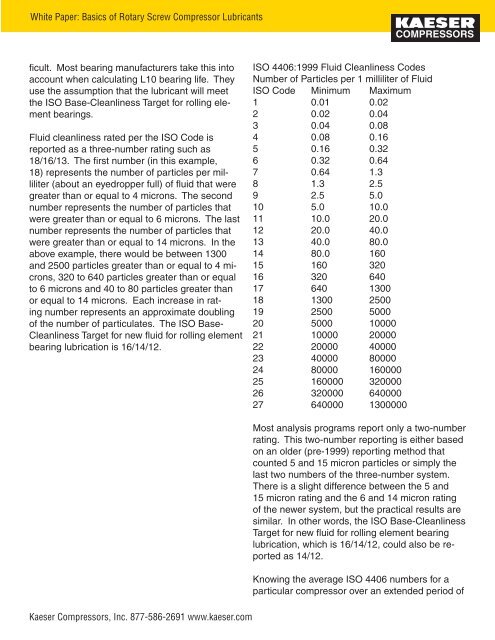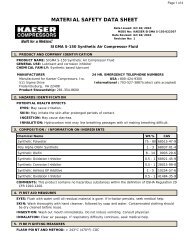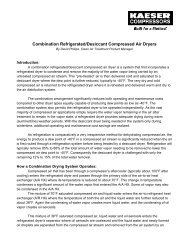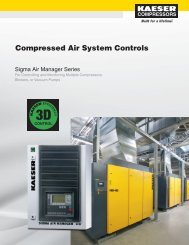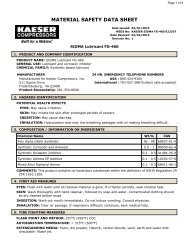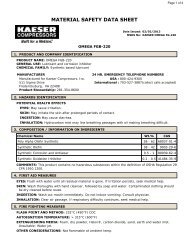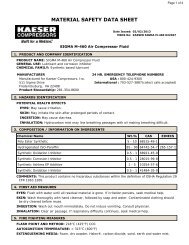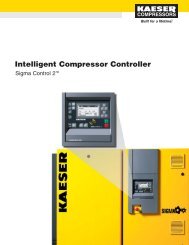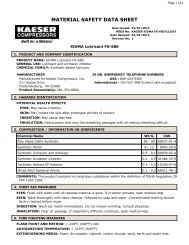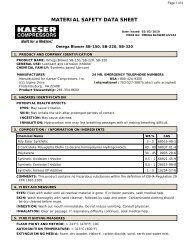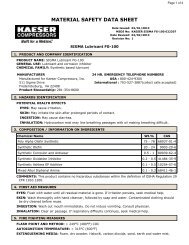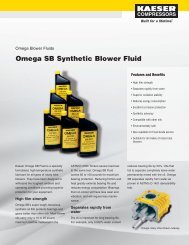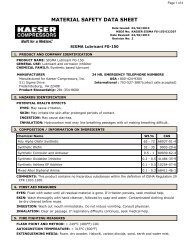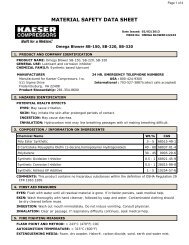Basics of rotary screw compressor lubricants - Kaeser Compressors
Basics of rotary screw compressor lubricants - Kaeser Compressors
Basics of rotary screw compressor lubricants - Kaeser Compressors
Create successful ePaper yourself
Turn your PDF publications into a flip-book with our unique Google optimized e-Paper software.
White Paper: <strong>Basics</strong> <strong>of</strong> Rotary Screw Compressor Lubricants<br />
ficult. Most bearing manufacturers take this into<br />
account when calculating L10 bearing life. They<br />
use the assumption that the lubricant will meet<br />
the ISO Base-Cleanliness Target for rolling element<br />
bearings.<br />
Fluid cleanliness rated per the ISO Code is<br />
reported as a three-number rating such as<br />
18/16/13. The first number (in this example,<br />
18) represents the number <strong>of</strong> particles per milliliter<br />
(about an eyedropper full) <strong>of</strong> fluid that were<br />
greater than or equal to 4 microns. The second<br />
number represents the number <strong>of</strong> particles that<br />
were greater than or equal to 6 microns. The last<br />
number represents the number <strong>of</strong> particles that<br />
were greater than or equal to 14 microns. In the<br />
above example, there would be between 1300<br />
and 2500 particles greater than or equal to 4 microns,<br />
320 to 640 particles greater than or equal<br />
to 6 microns and 40 to 80 particles greater than<br />
or equal to 14 microns. Each increase in rating<br />
number represents an approximate doubling<br />
<strong>of</strong> the number <strong>of</strong> particulates. The ISO Base-<br />
Cleanliness Target for new fluid for rolling element<br />
bearing lubrication is 16/14/12.<br />
ISO 4406:1999 Fluid Cleanliness Codes<br />
Number <strong>of</strong> Particles per 1 milliliter <strong>of</strong> Fluid<br />
ISO Code Minimum Maximum<br />
1 0.01 0.02<br />
2 0.02 0.04<br />
3 0.04 0.08<br />
4 0.08 0.16<br />
5 0.16 0.32<br />
6 0.32 0.64<br />
7 0.64 1.3<br />
8 1.3 2.5<br />
9 2.5 5.0<br />
10 5.0 10.0<br />
11 10.0 20.0<br />
12 20.0 40.0<br />
13 40.0 80.0<br />
14 80.0 160<br />
15 160 320<br />
16 320 640<br />
17 640 1300<br />
18 1300 2500<br />
19 2500 5000<br />
20 5000 10000<br />
21 10000 20000<br />
22 20000 40000<br />
23 40000 80000<br />
24 80000 160000<br />
25 160000 320000<br />
26 320000 640000<br />
27 640000 1300000<br />
<strong>Kaeser</strong> <strong>Compressors</strong>, Inc. 877-586-2691 www.kaeser.com<br />
Most analysis programs report only a two-number<br />
rating. This two-number reporting is either based<br />
on an older (pre-1999) reporting method that<br />
counted 5 and 15 micron particles or simply the<br />
last two numbers <strong>of</strong> the three-number system.<br />
There is a slight difference between the 5 and<br />
15 micron rating and the 6 and 14 micron rating<br />
<strong>of</strong> the newer system, but the practical results are<br />
similar. In other words, the ISO Base-Cleanliness<br />
Target for new fluid for rolling element bearing<br />
lubrication, which is 16/14/12, could also be reported<br />
as 14/12.<br />
Knowing the average ISO 4406 numbers for a<br />
particular <strong>compressor</strong> over an extended period <strong>of</strong>


